The chemical composition and nutritional value of buckwheat - a detailed description with tables
Buckwheat holds the lead among cereals in terms of the content of nutrients. Moreover, in boiled form, it is low in calories, which allows it to be included in most diets. Due to the chemical composition of buckwheat, dishes made from it are beneficial for the health of children and adults, saturate the body and help fight excess weight.
The content of the article
Chemical, mineral composition and nutritional value of buckwheat
The benefits of this cereal depend on the preparation method.... With intensive heat treatment, some of the vitamins and minerals are destroyed. Most of the useful substances are preserved by buckwheat dishes steamed in a thermos, stewed in an oven or oven. The most gentle way - pour boiling water over the cereal for a few hours in a thermos.
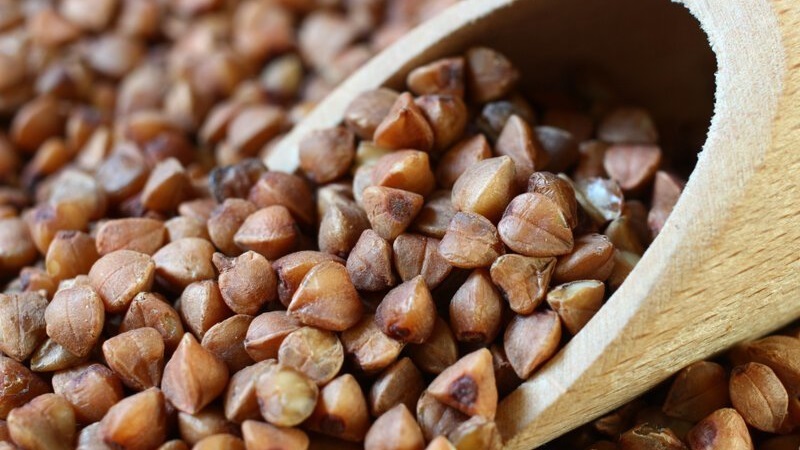
Trace elements and minerals
Buckwheat grains contain a large amount of nutrients... Some of them are rare, so cereals must be included in the diet at least three times a week.
| Trace element | Content (in 100 g), μg |
| Aluminum | 33,3 |
| Boron | 350 |
| Vanadium | 170 |
| Iron | 6700 |
| Iodine | 3,3 |
| Cobalt | 3,1 |
| Lithium | 4,2 |
| Manganese | 1560 |
| Copper | 640 |
| Molybdenum | 34,4 |
| Nickel | 10,1 |
| Rubidium | 52,5 |
| Selenium | 5,7 |
| Strontium | 304 |
| Titanium | 33 |
| Fluorine | 23 |
| Chromium | 4 |
| Zinc | 2050 |
| Zirconium | 35 |
The largest share of trace elements in buckwheat falls on iron, manganese and zinc.
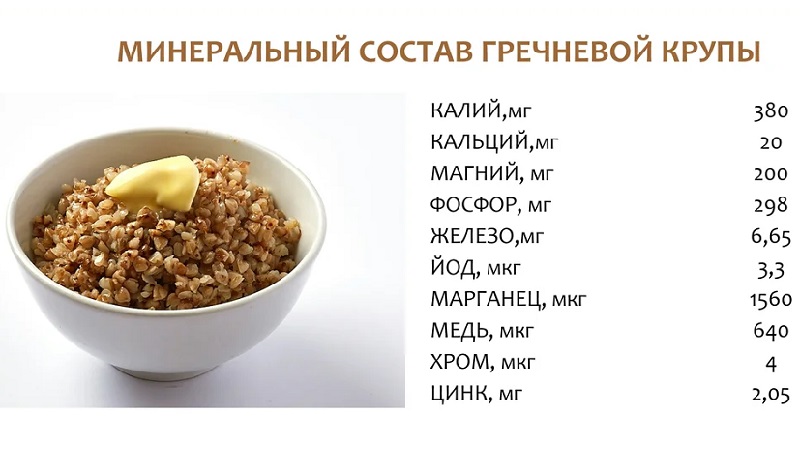
Iron in the human body is mainly found in blood hemoglobin, a fifth - in the liver, bone marrow and muscles, the same amount is involved in the synthesis of cellular enzymes.
Manganese is indispensable for the nervous system, participates in the regulation of lipid and carbohydrate metabolism, the metabolism of thyroxine (thyroid hormone), is necessary for the formation of erythrocytes and an increase in hemoglobin levels. Without this mineral, the likelihood of developing various pathologies in embryos and young children increases, immunity decreases, and the risk of cardiovascular and oncological diseases appears.
Zinc is the second most important element after iron for the human body.... It is involved in the synthesis of fats, carbohydrates and proteins. Serves as the basis for hormones, leukocytes, antibodies. Not a single metabolic process of the body can do without zinc. A deficiency of this trace element leads to severe damage, all systems suffer - the digestive, reproductive, nervous, bone, respiratory, hormonal, nervous.
Important! Chicken meat is considered equal to buckwheat in terms of zinc content, manganese - spinach and pumpkin seeds, iron - beef liver.
Iodine
Is there iodine in buckwheat? Most of all it is found in seafood, cranberries, prunes, strawberries. However, many allergy for fish, and fresh berries are not always available. Buckwheat contains iodine only 2.2% of the daily value... Therefore, this cereal helps maintain iodine levels in the body if consumed frequently.
Important! A deficiency of this element leads to disorders in the thyroid gland. Iodine is essential for pregnant women to develop a healthy baby.
How much iron is in boiled buckwheat
Thermally processed cereals contain exactly three times less glandthan in a dry product. Cooking porridge in a thermos helps to preserve the mineral as much as possible: dry cereal is poured with boiling water 1: 2 and left overnight. In the morning, the hot crumbly porridge is ready to eat. At the same time, it retains the maximum number of useful elements.
Phytic acid
This nutrient is very beneficial for the body.... Phytic acid has antioxidant and antitumor effects. It prevents the formation of kidney stones, atherosclerosis, and prevents the development of inflammatory diseases.
Wherein phytate binds some elements, preventing them from being absorbed by organisms... Primarily zinc, iron, manganese, calcium and magnesium. That is, those elements that provide the maximum benefit of buckwheat dishes.
Important! To neutralize the phytic acid in buckwheat, it is enough to soak the kernel for 4-6 hours before cooking. Another method is sprouting and fermentation, but it only applies to green buckwheat.
Macronutrients
These elements are contained in buckwheat in significant quantities, thanks to which it is of great benefit to the human body.
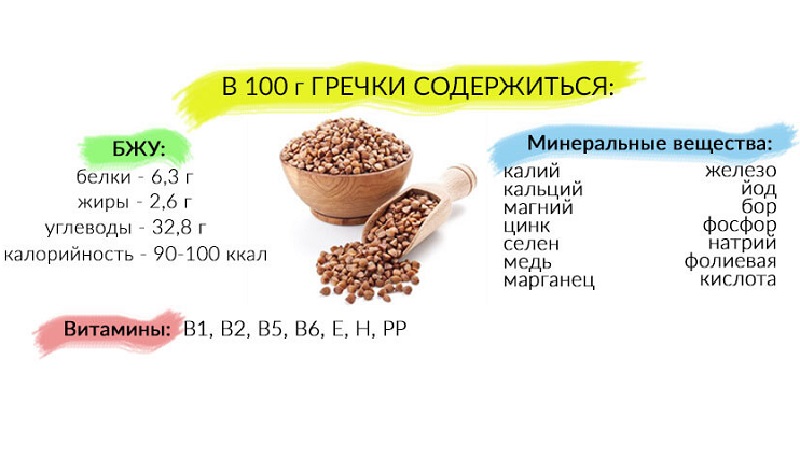
| Macronutrients | Content (in 100 g), mg |
| Potassium | 380 |
| Calcium | 20 |
| Silicon | 81 |
| Magnesium | 200 |
| Sodium | 3 |
| Sulfur | 88 |
| Phosphorus | 298 |
| Chlorine | 33 |
All macronutrients are found in cereals in an easily digestible form, therefore, the inclusion of buckwheat in a constant diet allows maintaining the balance of minerals in the norm.
Magnesium
Magnesium is in fourth place in terms of importance for the human body... This intracellular element of all tissues is involved in maintaining fluid balance, enzymatic reactions.
Magnesium deficiency affects the state of the nervous system - there is a tremor of the limbs, dizziness, convulsions. In severe conditions, depression, insomnia, panic attacks, and increased fatigue are observed.
From the side of the cardiovascular system with a deficiency of magnesium, it is possible hypertension, tachycardia, increased risk of coronary heart disease (CHD). Therefore, regular consumption of buckwheat, rich in magnesium, contributes to the maintenance of health for many years.
Sodium
This the element provides the transport of substances into and out of the cell, regulates the level of body fluids, is responsible for the acid-base balance, is directly involved in metabolic processes.
Important! Sodium deficiency in the body is rare, but its excess leads to edema and hypertension.
Phosphorus content
This the element takes care of building and maintaining the health of bone tissue, including it is very important for the strength of the teeth. Phosphorus is actively involved in many metabolic processes: energy, protein, carbohydrate. Along with other elements, it maintains the acid-base balance. 100 g of buckwheat contains almost half the daily requirement of phosphorus.
How much calcium is in buckwheat
Calcium in the human body is found in large quantities - up to 1.5 kg... Mainly in bones and teeth. Moreover, its role in maintaining the strength of the skeleton is not limited. Calcium is responsible for muscle contraction, including the walls of blood vessels and the myocardium. The synthesis of hormones is also not complete without this mineral. Calcium takes part in the synthesis of neurotransmitters, complex proteins and hormones.
Important! Despite the fact that 100 g of buckwheat contains only 2% of the daily value of the mineral, from this product it enters the body in balance with its other "associates" in maintaining the most important functions - potassium, sodium, magnesium and manganese.
Silicon
This the element is necessary for maintaining joint mobility and normal functioning of internal organs... Buckwheat contains 270% of the daily value of silicon, but not all of it is absorbed by the body. Foods rich in this mineral are especially beneficial for menopausal women.
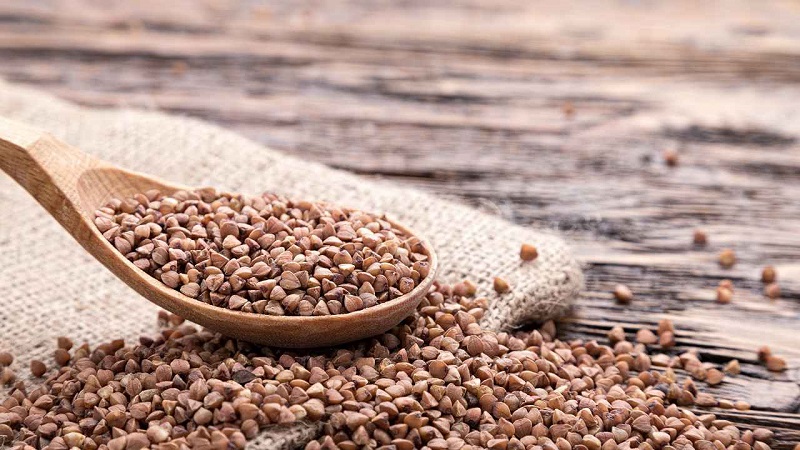
The amino acid composition of buckwheat
These substances are necessary for the human body to ensuring smooth and correct operation.
| Amino acids | Content (in 100 g), g |
| Irreplaceable | |
| Arginine | 1,1 |
| Valine | 0,6 |
| Histidine | 0,3 |
| Isoleucine | 0,5 |
| Leucine | 0,8 |
| Lysine | 0,5 |
| Methionine | 0,3 |
| Threonine | 0,4 |
| Tryptophan | 0,2 |
| Phenylalanine | 0,6 |
| Replaceable | |
| Alanin | 0,6 |
| Aspartic acid | 1,1 |
| Glycine | 0,7 |
| Glutamic acid | 2,3 |
| Proline | 0,5 |
| Serine | 0,6 |
| Tyrosine | 0,4 |
| Cysteine | 0,3 |
The content of all essential acids in 100 g of buckwheat is 10% from the daily needs of the body.
Arginine in buckwheat
Until the age of 30, this conditionally nonessential acid is synthesized by the body in small amounts.... However, this process may stop earlier if the person is taking antibiotics, receiving chemotherapy treatment, or having a long history of illness.
Arginine's role is mainly in vasodilation... That is why it is indispensable for improving the functioning of the heart, brain, blood vessels, stabilization of blood pressure.
Vitamins
Vitamins contained in the core, have a beneficial effect on all human organs and systems... There is such a variety of them in buckwheat, which is not found in any other cereal.
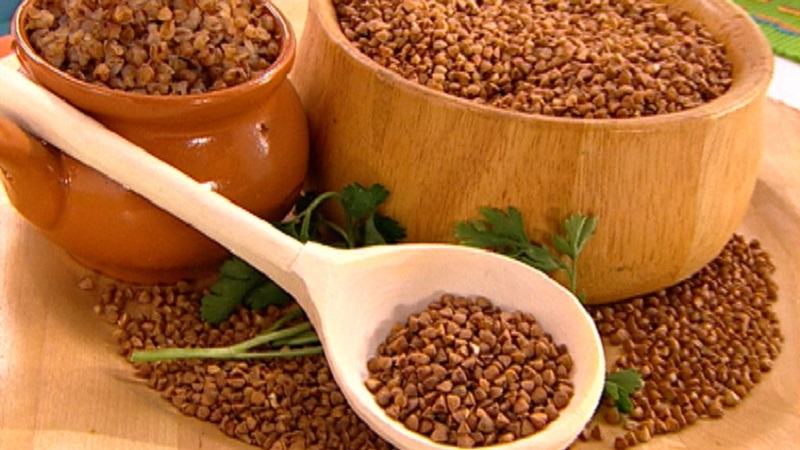
The composition of vitamins in the kernel (per 100 g):
- A (carotene) - 2 μg;
- B1 (thiamine) - 0.43 mg;
- B2 (riboflavin) - 0.2 mg;
- B4 (choline) - 54.2 mg;
- B5 (pantothenic acid) - 0.44 mg;
- B6 (pyridoxine) - 0.4 mg;
- B9 (folate) - 32 mcg;
- E (tocopherol) - 0.8 mg;
- H (biotin) - 10 μg;
- K (phylloquinone) - 7 μg;
- PP (nicotinic acid) - 7.2 mg.
Vitamins PP, A, B4 are completely destroyed during prolonged heat treatment, therefore, in case of their lack in the body, gentle methods of preparing cereals should be used.
Nutritional value and calorie content
Buckwheat is a nutritious product. Despite the increased calorie content, dishes made from it are considered dietary due to their low glycemic index... It is only 50 units, so buckwheat is recommended for regulating sugar levels in diabetic food.
Nutritional value of buckwheat, in 100 g:
- proteins - 12.6 g;
- fats - 3.3 g;
- carbohydrates - 57.1 g;
- cellulose - 11.3 g;
- water - 14 g;
- energy value - 308 kcal.
Calorie content of boiled buckwheat is only 103 kcal, so it belongs to dietary products.
Conclusion
Buckwheat is a healthy, nutritious product with a low calorie content. The chemical composition of cereals makes it one of the most essential crops for inclusion in the diet. A wide variety of dishes are prepared from buckwheat, so even 3-4 times a week it does not get boring. To preserve the most valuable vitamins and minerals, it is better not to boil cereals, but to steam them in a thermos.